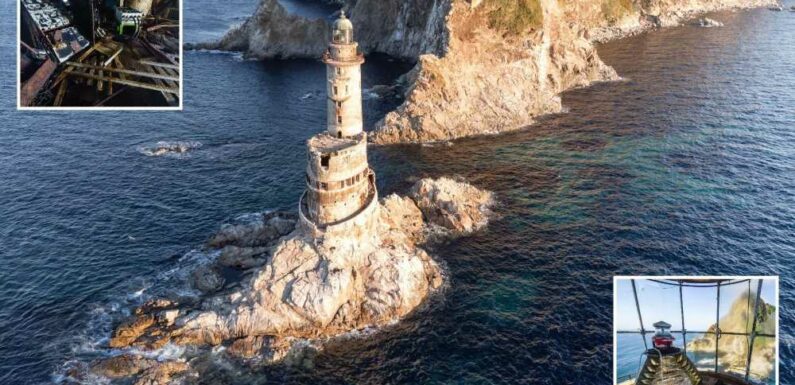
PERCHED on a remote rock and falling into ruins, this nuclear-powered lighthouse is an unlikely tourist attraction.
Yet every year hundreds of visitors make the bumpy voyage to climb the abandoned tower at Cape Aniva, in the far east of Russia.
The crumbling structure once housed 12 crew at a time, but now only seagulls and their chicks call it home.
Also known as Nakashiretoko, it was built by Japanese engineers from 1937 to 1939 at the southern tip of Sakhalin island.
At the time, the southern half of the 600-mile-long island was part of the Japanese empire while the northern half was Russian.
The cape at Aniva is inaccessible on land and hard to reach by boat, but the workers managed to build a nine-storey concrete lighthouse towering 100ft above the waves.
read more abandoned places
Inside the secret abandoned tube station used in Hollywood movies & how to visit
Inside abandoned $250million mansion with tragic link to sinking of the Titanic
Its exposed position means the light – which revolved on a bed of liquid mercury – could be seen up to 19 nautical miles away.
And it was essential as the strait it overlooks is notorious for hazards, including underwater currents, frequent fog and hidden rocky shoals.
After World War II the Soviet Union annexed the whole island and half a million Japanese people were shipped back to Hokkaido.
The Soviets then took over the operation of the lighthouse – and installed "atomic batteries" to power it.
Most read in The Sun
Holly Willoughby falls backwards down the stairs in dramatic on-air accident
I could have saved my speech but I made one huge mistake, says Chris Kamara
Seven bombshell revelations in Meghan Markle and Prince Harry’s Netflix doc
Katie Price flees country with her youngest kids & Carl Woods amid ex's arrest
It was one of a total of 132 Soviet lighthouses that used radioisotope thermoelectric generators.
These are a kind of giant battery that convert the heat generated by the decay of a radioactive material – in this case strontium-90 – into electricity.
They are ideal in remote locations with no infrastructure, providing reliable power for up to ten years before they need to be replaced.
Similar generators have also been used on Nasa space probes.
The USSR automated the Aniva lighthouse and withdrew all the workers in 1990.
It continued to be powered by atomic batteries until 2006, since when it has been abandoned.
Now tourists come to peer inside the former control room and sleeping quarters, and admire the view from the top.
“The lighthouse is in satisfactory condition for now”, travel expert Dmitri Kulikov told the Russia Beyond website.
“It is still safe to visit, but it may soon become dangerous, as there are parts that have begun to deteriorate.
“While the tower is made of concrete, parts of the brickwork, metal doors and structures have begun to rust badly.”
However this is one attraction that is well off the beaten path.
Getting to Aniva cape involves a 90-minute drive from the nearest settlement, followed by a two-hour boat journey.
Visitors then have to clamber up the rocks using ropes to reach the base of the lighthouse.
Those who have been say it is worth the effort.
“When tourists get there for the first time, it always has a ‘wow-effect’ on them,”said Kulikov.
“The lighthouse looks epic: rugged, unyielding, it stands in the middle of the sea and overhangs a steep cliff.
“It’s completely grey now, but, if you look closely, you can see that it used to be coloured in stripes.
“It conveys an impression of total abandonment.”
Read More on The Sun
Dad shares hilarious Elf on the Shelf fail which leaves son traumatised
We went to the ‘WORST Christmas Market in Britain’ & it’s a total rip off
If you like the idea of it – but want something closer to home – you can rent a former lighthouse off the coast of Croatia as a holiday home from £28 a night.
Another creepy tourist attraction is former mining colony Hashima Island, which was used as the villain's lair in Bond movie Skyfall.
Source: Read Full Article















